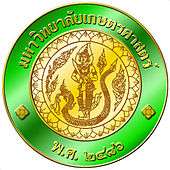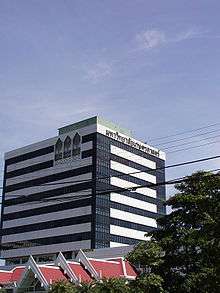Kasetsart University
| มหาวิทยาลัยเกษตรศาสตร์ | |
 | |
| Motto |
• (official) • People own the nation and their taxes become Kasetsart (unofficial) |
|---|---|
| Type | Public (National) research university |
| Established | 1943 |
| President | Assoc. Prof. Dr Bancha Kwanyuen (acting)[1] |
Academic staff | 2,944[2] |
Administrative staff | 6,661 |
| Students | 66,755[3] |
| Undergraduates | 54,748 (2014 academic year) |
| Postgraduates | 11,955 (2014 academic year) |
| Location |
Bang Khen, Bangkok, Thailand 13°50′54.95″N 100°34′04.98″E / 13.8485972°N 100.5680500°ECoordinates: 13°50′54.95″N 100°34′04.98″E / 13.8485972°N 100.5680500°E |
| Campus | Urban and Rural (varied by campus) |
| Anthem | "Kasetsart" |
| Colours | Forest green[4] |
| Mascot | Nonsri (tree), (Peltophorum pterocarpum)[4] |
| Affiliations | ASAIHL |
| Website |
www |
Kasetsart University (Thai: มหาวิทยาลัยเกษตรศาสตร์; rtgs: Maha Witthayalai Kasetsat) is a public university in Thailand. It is ranked in the 651-700 tranche in the QS World University Rankings 2015/16.[5] It was the first agricultural university and the third oldest university in Thailand. It was established on 2 February 1943, to promote subjects related to agricultural science. Since then, Kasetsart University has expanded its subject areas to cover science, arts, social sciences, humanities, education, engineering, and architecture. The university also intends to include medicine and health science in the future. Kasetsart University is in Bang Khen, Bangkok, and now has four campuses, with an enrolment of approximately 67,000 students. It is the largest university in Thailand.
History
The establishment of Kasetsart University was part of the evolution of agricultural education in the country, which began a system of technical schools. This may be divided into three periods.
Initial period (1904–1913)
Western-styled agricultural education in Thailand began with the establishment in 1904 of the School of Sericulture or Rong-Rian Chang Mai (โรงเรียนช่างไหม) in Tambon Thung Saladaeng, Bangkok, offering a two-year program entirely in sericulture. In 1906, the program was extended to three years and included cultivation of other crops and veterinary science. The name was then changed to the School of Agriculture or Rong-Rian Vicha Karn Porh Pluke (โรงเรียนวิชาการเพาะปลูก). In 1908, the school was merged with the School of Surveying and the School of Irrigation by the Ministry of Agriculture to train personnel to serve in the ministry. The school was renamed the School of the Ministry of Agriculture and Thailand's first tertiary-level agriculture curriculum was drawn up and was inaugurated in 1909. The school was merged with the Civil Service School in 1913 by the Government of Siam and was placed under the Ministry of Public Instruction and Religion.
Middle period (1914-1923)
During this time, the Primary School Agriculture Teacher Training School was established and offered a two-year higher education program awarding a certificate in primary school agricultural education. The school was initially in Bangkok but was moved to Nakhon Pathom Province in 1918.

Later period (1924-1942)
In 1924, the Primary School Agriculture Teacher Training School was moved to Prachuap Khiri Khan Province and a second branch of the school was established in Saraburi Province in 1926. At this time, agricultural education at both primary and secondary school levels were provided through various technical schools. In 1931, Siam's agricultural education was back in the hands of the Ministry of Agriculture as upcountry agricultural research stations and teacher training schools were planned to be set up in concert.
In 1933, the Mae Jo Primary School Agriculture Teacher Training School was established in Chiang Mai Province. The school is now known as Mae Jo University, Kasetsart's sister university that shares the same insignia.
In 1935, as the number of agriculture teachers exceeded the demand, the government planned to close down three news primary agriculture teacher training schools, one of which was Mae Jo. The three founding fathers of Kasetsart — Luang Ingkhasikasikan, Luang Suwan Vajokkasikij, and Phra Chuangkasetsinlapakan — proposed a project whereby Mae Jo was retained as a secondary-level agriculture technical school. This was later elevated to become the College of Agriculture, with the status of a division in the Department of Agriculture and Fisheries.
In 1938, the Ministry of Agriculture established the Central Agriculture Station, or Kaset Klang (เกษตรกลาง) in Bang Khen District of Bangkok, and the College of Agriculture was moved down from Chiang Mai to Bangkok as well. The college offered three-year certificate programs in agriculture, cooperative science, and forestry.
On 2 February 1943, Kasetsart University (มหาวิทยาลัยเกษตรศาสตร์), translated as the "University of Agriculture", was founded by the Kasetsart University Act of 1943. The university offers programs in agriculture, agro-industry, forestry, fisheries, and engineering.
Campuses and faculties
Campuses[6]
- Bang Khen District (Main, original campus). Due to the split of Bang Khen District, the campus is now in Chatuchak District, six kilometres south of Don Mueang Airport.
- Kamphaeng Saen District
- Si Racha District
- Chalermphrakiat, Sakon Nakhon Province
Faculties

Bang Khen Campus
- Faculty of Agriculture
- Faculty of Agro-Industry
- Faculty of Architecture
- Faculty of Business Administration
- Faculty of Economics
- Faculty of Education
- Faculty of Engineering
- Faculty of Environment
- Faculty of Fisheries
- Faculty of Forestry
- Faculty of Humanities
- Faculty of Science
- Faculty of Social Sciences
- Faculty of Veterinary Medicine
- Faculty of Veterinary Technology
- Graduate School
Kamphaeng Saen Campus
- Faculty of Agriculture at Kamphaeng Saen
- Faculty of Engineering at Kamphaeng Saen
- Faculty of Education and Development Sciences
- Faculty of Liberal Arts and Science
- Faculty of Sports Science
- Faculty of Veterinary Medicine
Si Racha Campus
- Faculty of Management Science
- Faculty of Engineering at Si Racha
- Faculty of Science at Si Racha
- Faculty of Economics at Si Racha
- International Maritime College
Chalermphrakiat Sakhon Nakhon Campus
- Faculty of Natural Resources and Agro-Industry
- Faculty of Science and Engineering
- Faculty of Liberal Arts and Management Sciences
- Faculty of Public Health
See also
- List of universities in Thailand
- List of colleges and universities
- Kasetsart University Laboratory School
References
- ↑ "The University Administration". Kasetsart University. Retrieved 16 October 2015.
- ↑ "Administration: Number of Personnel". Kasetsart University. Retrieved 22 November 2015.
- ↑ "Total Students". Kasetsart University. Retrieved 22 November 2015.
- 1 2 "Kasetsart Symbol". Kasetsart University. Retrieved 29 August 2015.
- ↑ "QS World University Rankings 2015/16". QS Top Universities. Retrieved 21 November 2015.
- ↑ "Campus". Kasetsart University. Retrieved 21 November 2015.
External links
| Wikimedia Commons has media related to Kasetsart University. |
- Official website (Thai)